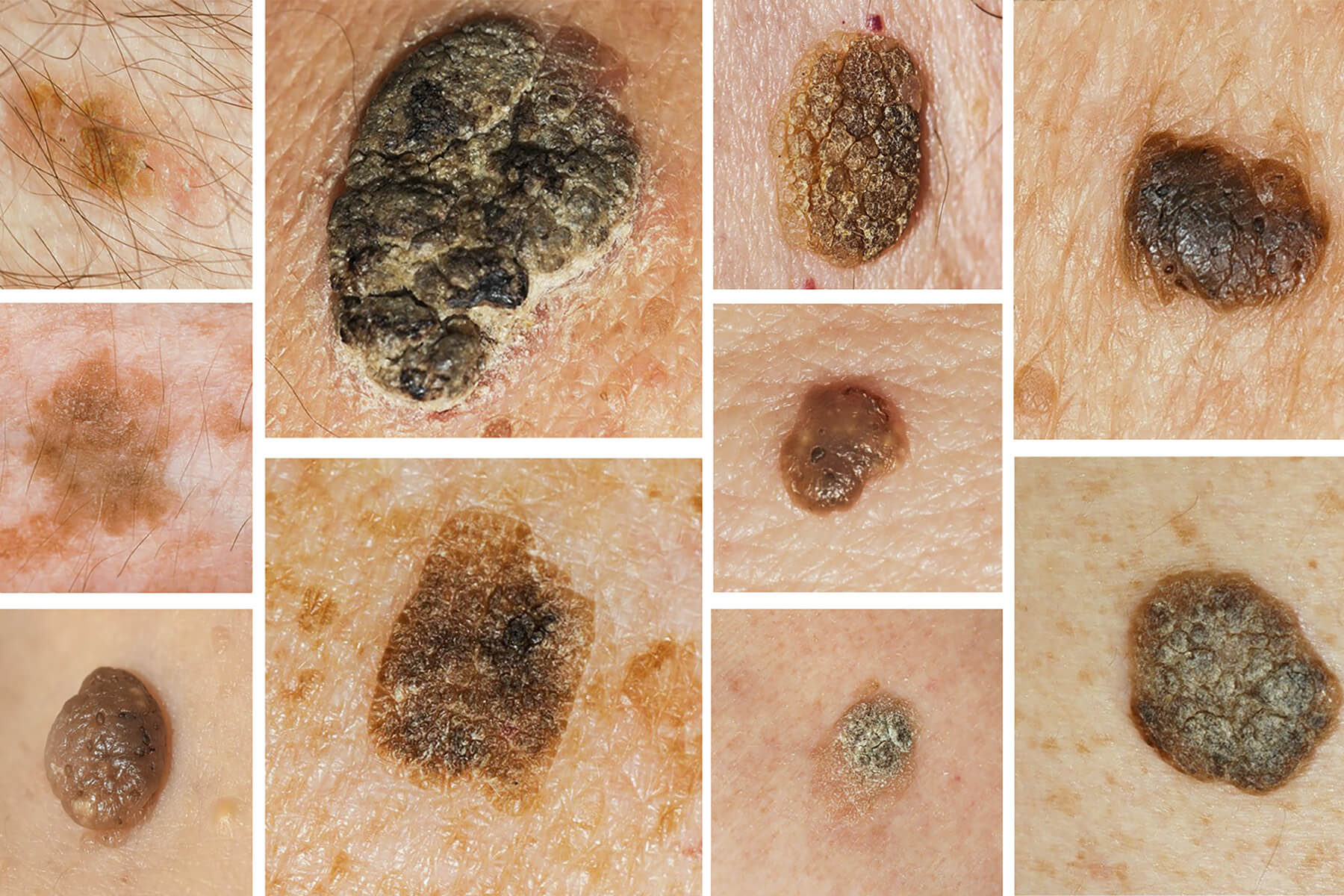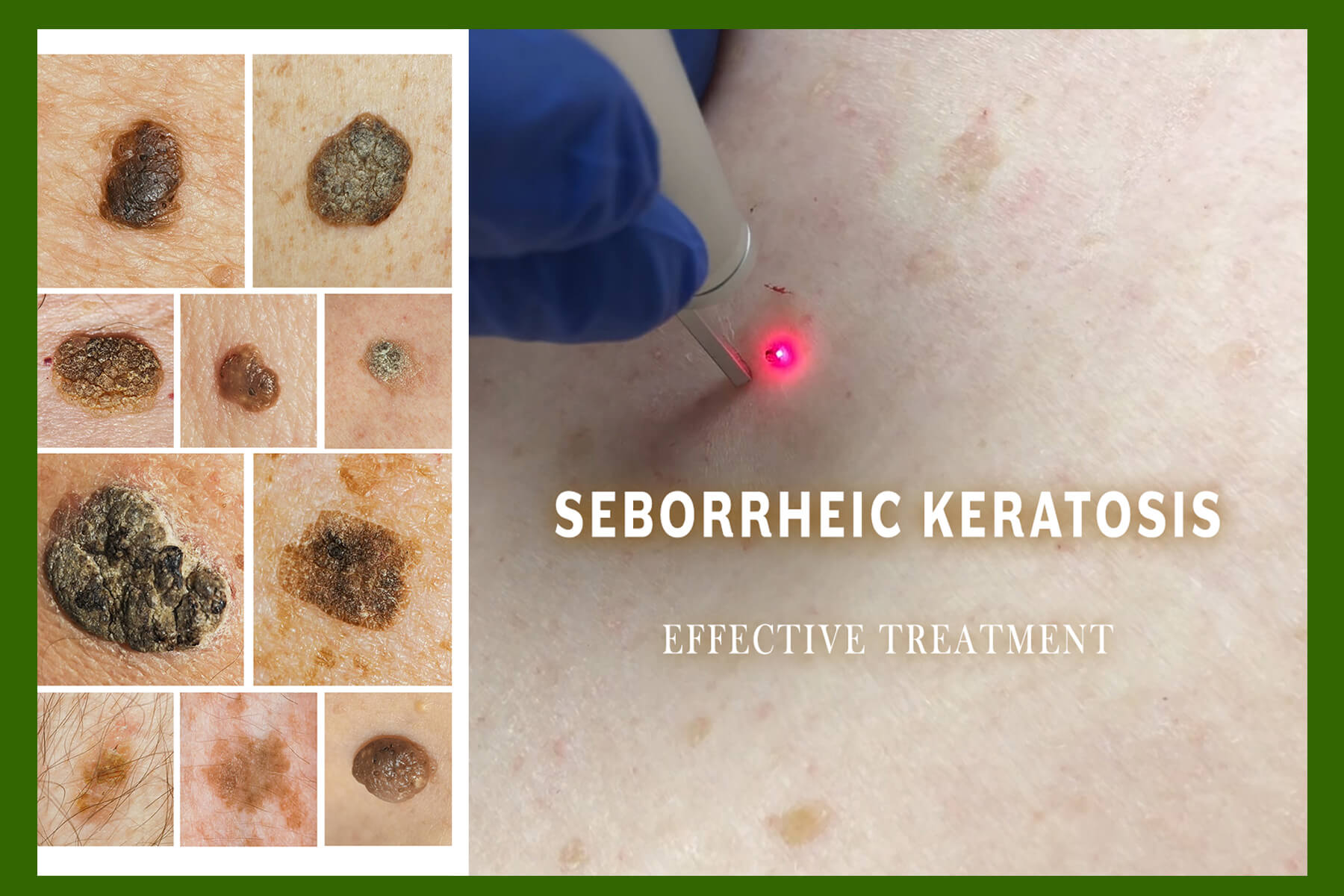Seborrheic Keratosis Removal Treatment in Laval and Greater Montreal Area – Causes, Risks and Painless Treatments
Seborrheic keratosis treatment at LABELLE Clinic
Seborrheic keratosis is a common skin condition that can cause discomfort and embarrassment. At LABELLE Clinic we offer advanced treatments to manage and treat this condition. This article explores the definition of seborrheic keratosis, its clinical presentation, as well as the treatment options available at LABELLE Clinic, including CO2 laser and cryotherapy.
Definition and manifestations of Seborrheic Keratosis
Seborrheic keratosis is a benign growth that often appears on the skin of older people. It presents as thick, rough, flesh-colored to dark brown lesions that may look like warts. Seborrheic keratoses, also known as seborrheic warts, are very common in adults, especially from the age of 40/50. In some exceptional cases, many seborrheic keratoses can appear all at once, sometimes with a large size and rapid development. It is a benign skin tumor that takes the form of a slightly raised lesion similar to a wart. Its size can vary from a few millimeters to a few centimeters. Often beige in color (especially at first) it becomes browner then black, it has a greasy appearance and above all thickens and widens over time. Seborrheic keratoses are most often located on the trunk, but can appear all over the body. They are most often in areas of friction and perspiration (under the bra in women, on the neck and back in men). It can also be seen on the face and in the scalp. We almost always find a family origin… Their surface can take on a warty, crusty and rough appearance. They are painless to the touch and present no risk of associated cancer or contagion. The only downside is that they are mostly unsightly.

Clinical Presentation
- Appearance
Seborrheic keratosis is a superficial epithelial lesion that is often pigmented, usually verrucous, but can sometimes take on a smooth papular appearance. The size of seborrheic keratoses is variable and increases slowly with age. They can be round or oval and flesh-colored, brown, or black. They usually appear as "laid on the skin" and may have a warty, smooth, scaly or crusty surface. Seborrheic keratoses correspond to small single or multiple lesions which look like crusts of brown ocher color at first then which become dark brown or even blackish over time. At first rough, they then tend to thicken. Seborrheic keratoses can look like warts, moles, or skin cancer. Their appearance is waxy and they seem to be glued to the skin. Some may look like a drop of brown wax.
- Location
Seborrheic keratosis is usually located on the trunk, chafing areas, under the chest, and sometimes the face. Seborrheic keratoses can develop anywhere on the skin, but more typically on so-called seborrheic areas: the face, chest and back. This skin lesion can also appear at the level of wool folds, breast folds and around the nipple. In dark-skinned people, many of these growths may appear on the cheekbones (black papular dermatosis).
- Symptoms
Symptoms of seborrheic keratosis can vary from person to person, but include the appearance of patches or lesions on the skin, usually light to dark brown in color. Seborrheic keratoses are superficial epithelial lesions that are often pigmented, usually verrucous, but which can sometimes take on a smooth papular appearance. They can be round or oval and flesh-colored, brown, or black. They usually appear as "laid on the skin" and may have a warty, smooth, scaly or crusty surface. Although generally harmless, they can sometimes be itchy or irritating, especially if rubbed by clothing.
- Causes
The exact cause of seborrheic keratosis is not completely understood. However, several factors can contribute to its occurrence, including genetic factors. A family history of seborrheic keratosis may increase the risk of developing this condition. Seborrheic keratoses are benign pigmented lesions and their cause is unknown. They tend to develop in older people.
- Risks
In general, seborrheic keratoses are harmless skin growths. However, in rare cases, they can become cancerous. Seborrheic keratoses are not precancerous lesions and they do not require treatment unless they are irritated, itchy or unsightly. If you have any concerns regarding your seborrheic keratoses, it is recommended that you consult with us for proper diagnosis and treatment.

CO2 Laser Treatment at LABELLE Clinic
The CO2 laser is an effective and revolutionary method to treat seborrheic keratosis.
- Procedure
The CO2 laser is a type of laser that uses carbon dioxide to produce an intense and precise beam of light. This beam is used to remove the superficial layers of the skin, which makes it possible to treat seborrheic keratoses. CO2 laser treatment is fast, effective and usually leaves no scars. It can be performed in a single session or in several sessions, depending on the size and number of keratoses to be treated. Before the treatment, the doctor will clean the area to be treated and apply a numbing cream to reduce discomfort. During the treatment, the doctor will use the CO2 laser to remove the seborrheic keratoses. You may feel a slight tingling or burning sensation during the treatment, but this should be tolerable. After the treatment, the treated area will be red and swollen for a few days. You will need to follow the doctor's instructions to take care of the treated area and avoid sun exposure. CO2 laser treatment is a safe and effective method to treat seborrheic keratoses. If you have seborrheic keratoses and would like to have them removed, do not hesitate to contact us to discuss the treatment options available.
- Advantages - fast, minimally invasive and effective
CO2 laser treatment is considered to be the best treatment for seborrheic keratoses. It has many advantages over other methods of treatment. First of all, the CO2 laser is very precise and can only target seborrheic keratoses without damaging the surrounding skin. This means that the treatment is less invasive and less painful than other methods, such as cryotherapy or surgical excision. In addition, the CO2 laser treatment is fast and can be performed in a single session or in several sessions, depending on the size and number of keratoses to be treated. This means that you can resume your normal activities shortly after treatment. The CO2 laser does not generally leave scars, which is an important advantage for people who wish to treat seborrheic keratoses on visible areas of the body, such as the face. Finally, CO2 laser treatment is very effective in eliminating seborrhoeic keratoses. In most cases, a single treatment session is enough to completely remove the keratoses. This means that you will not need to undergo multiple treatments to achieve satisfactory results. Most patients do not see a reappearance of the lesion after treatment. In summary, CO2 laser treatment has many benefits for people with seborrheic keratoses. It is precise, fast, minimally invasive and effective.
- The cost of co2 laser seborrheic keratosis treatment
The cost of CO2 laser treatment to treat seborrheic keratosis at LABELLE Clinic can vary depending on several factors, such as the number of keratoses to be treated and the complexity of the treatment. We suggest that you contact our clinic, which specializes in this type of treatment, directly to obtain an appointment for evaluation and identification of treatment costs.

TREATMENT OF SEBORRHEIC KERATOSIS WITH CO2 LASER - TESTIMONY
We present to you an honest testimony on the treatment of seborrheic keratos with the CO2 laser, carried out by the specialists of our clinic.
Treating Seborrheic Keratosis With Cryotherapy
Cryotherapy is another option to treat seborrheic keratosis. Cryotherapy is a treatment method that uses liquid nitrogen to freeze and destroy abnormal tissue, including seborrhoeic keratoses. This method is often used to treat small seborrheic keratoses, especially those found on the face and neck.
- Procedure
The cryotherapy procedure to treat seborrheic keratoses is simple and quick. The doctor will apply liquid nitrogen directly to the keratosis using a cotton swab or spray bottle. Liquid nitrogen quickly freezes tissue, causing a blister to form. The seborrheic keratosis will then peel away from the skin as the blister heals. Cryotherapy can be mildly painful, but the pain usually goes away quickly. After treatment, the treated area may be red and swollen for a few days. You will need to follow the doctor's instructions to take care of the treated area and avoid sun exposure. Cryotherapy is an effective method for treating seborrheic keratoses, but it may not be right for everyone. If you have seborrhoeic keratoses and would like to have them removed, do not hesitate to contact us to discuss the treatment options available.
- Advantages
First of all, cryotherapy is a fast and effective method to treat seborrheic keratoses. The procedure only takes a few minutes and can be done in one sitting. This means that you can resume your normal activities shortly after treatment. Additionally, cryotherapy is minimally invasive and usually leaves no scars. This means that you won't have to worry about scars or marks left behind by the treatment. Cryotherapy can also be used to treat seborrheic keratoses on sensitive areas of the body, such as the face and neck. Finally, cryotherapy is a safe and well tolerated method. Most people feel only mild pain during treatment, which goes away quickly. After treatment, the treated area may be red and swollen for a few days, but these side effects are usually temporary and go away quickly. In summary, cryotherapy has many benefits for people with seborrheic keratoses. It is fast, effective, minimally invasive and well tolerated.
- Side effects
Although this method is generally safe and well tolerated, it can sometimes cause side effects. One of the most common side effects of cryotherapy is pain or discomfort during treatment. When liquid nitrogen is applied to the skin, it may cause a stinging or burning sensation. This pain is usually mild and goes away quickly after treatment. After treatment, the treated area may be red and swollen for a few days. This is normal and should go away quickly. In some cases, cryotherapy can also cause blisters or crusts on the skin. These side effects are usually temporary and disappear within a few days. In rare cases, cryotherapy can cause scarring or changes in skin pigmentation. These side effects are more common in people with dark or sensitive skin. If you have any concerns about the side effects of cryotherapy, it is recommended that you consult a dermatologist for medical advice. In summary, although cryotherapy is a safe and effective method for treating seborrheic keratoses, it can sometimes cause side effects such as pain, swelling, blistering or scarring. If you have any concerns about these side effects, do not hesitate to consult us for medical advice.
- The cost of cryotherapy treatment
The cost of treatment with the cryotherapy procedure at LABELLE Clinic can vary depending on several factors, such as the number of keratoses to be treated and the complexity of the treatment. We suggest that you contact our clinic, which specializes in this type of treatment, directly to obtain an appointment for evaluation and identification of treatment costs.


